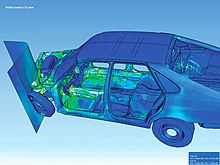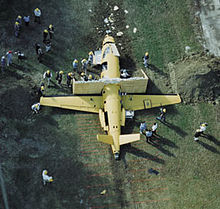Crash safety

Crash safety describes the ability of a structure to protect people in the event of an accident. It is usually a subgroup of vehicle safety and is calculated using the finite element method (FEM) and verified with crash tests .
Aerospace
The first scientific work in the 1950s and 1960s focused on improving the crash safety of helicopters and aircraft of the US Army in order to reduce or avoid spinal damage during the Vietnam War .
Even today, for example, within the framework of joint research projects, simulation tools and construction methods for optimizing crash and impact safety are developed, and studies are carried out on both foreign object and aircraft impact simulations.
Rail vehicle construction
In rail vehicle technology, collisions of a rail vehicle with another rail vehicle, a road vehicle (for example on a level crossing ) and an obstacle lying on the track are considered. These collision scenarios with specific load values have been recorded in the EN 15227 standard since 2008 . Rail vehicle manufacturers try to reduce the consequences of a collision through various components and measures:

- Anti-climbing protection : Especially with newer railcars , horizontally attached ribs at the vehicle ends and between the car bodies of multi-part vehicles, which prevent a car body from climbing up and the resulting collision of a stiff undercarriage with the less stiff passenger compartment, are widespread.
- Rail clearers : In order to avoid derailment of a rail vehicle due to an obstacle on the rails or a passenger car , according to European standards, rail clearers must withstand a central load of 300 kN or a load of 250 kN applied to their edge.
- Crash-optimized head module: In order to offer the train driver a guaranteed survival space in the event of accidents at level crossings, newer rail vehicles are equipped with head modules that connect to the actual car body structure and must be sufficiently stable to withstand, for example, an impact at 110 km / h on a truck or truck standing across to withstand an obstacle weighing 15 t at head level of the driver.
- Energy-absorbing elements: Often attached to the ends of a car body, these deformable components absorb deformation energy in the event of a collision and thus reduce the load on the car body structure. Usually, several energy-absorbing elements of different shapes are arranged one behind the other, so that first the front and later the rear energy-absorbing elements are activated.
- High-performance buffers: Mostly used in locomotives and freight wagons, which do not bend to the side in the event of a collision, but rather should fold up according to a defined pattern. The first developments in this area were made in Germany in the 1990s.
- Deformation tube: For central buffer couplings, attached between the coupling head and the car body or frame. It consists of two tubes with slightly different diameters that are pushed into one another during a collision and thus absorb energy.
In rail vehicle construction, crash tests are usually not carried out on the entire vehicle for cost reasons. Instead, a crash of the entire vehicle is simulated using the finite element method . Only structurally relevant components such as energy-absorbing elements are subjected to real tests. The results of the computer simulation are compared with the actual test results. For approval, the deformation of the tested component must not deviate by more than 10% from the calculated deformation in the entire vehicle; In addition, the timing of the deformation must match.
Automobile manufacturing

Today, crash safety in automotive engineering is of great importance, also by manufacturers and customers. Crumple zones , crash boxes , seat belts , airbags and seat belt tensioners serve to ensure the safety of vehicle occupants , and the effects on other road users are increasingly addressed in the context of pedestrian protection.
shipbuilding
In shipbuilding , collisions with floating or stationary bodies and running aground are taken into account in the context of crash safety.
Construction
Also in construction technology , e.g. B. in the event of a plane crash on nuclear power plants or when erecting guard rails at gatehouses or toll booths, crash safety is taken into account.
Individual evidence
- ^ The Evolution of Energy Absorption Systems for Crashworthy Helicopter Seats by Stan Desjardins, paper at 59th AHS Forum
- ↑ Human Tolerance and Crash Survival ( Memento of the original from June 3, 2012 in the Internet Archive ) Info: The archive link was inserted automatically and has not yet been checked. Please check the original and archive link according to the instructions and then remove this notice. - Shanahan (NATO)
- ^ History of Full-Scale Aircraft and Rotorcraft Crash Testing .
- ↑ Seminar on crash safety of aircraft in high-speed collisions.
- ↑ DIN EN 15227 - Railway applications - Requirements for the collision safety of rail vehicle bodies.
- ↑ More safety on European rails - New European standard for collision safety of rail vehicle bodies has been published. German Institute for Standardization , August 27, 2008, accessed on May 1, 2015.
- ^ A b Jürgen Janicki, Horst Reinhard, Michael Rüffner: Rail Vehicle Technology . Bahn-Fachverlag, Berlin 2013, ISBN 978-3-943214-07-9 .
- ↑ a b c d Alois Starlinger: Crash-appropriate design. In: Christian Schindler (Hrsg.): Handbuch rail vehicles. Eurailpress, Hamburg 2014, ISBN 978-3-7771-0427-0 , pp. 238-244.
- ^ Siegfried Kobert, Dietmar Busch: Train and shock devices. In: Christian Schindler (Hrsg.): Handbuch rail vehicles. Eurailpress, Hamburg 2014, ISBN 978-3-7771-0427-0 , pp. 436-444.
- ^ Christian Wüst: Bahn: Kink in the buffer. Der Spiegel, 49/2000 of December 4, 2000.
- ↑ Manolis Samuelides: Recent Advances and future trends in structural crashworthiness of ship structures Subjected to impact loads. In: Ships and Offshore Structures. 2015, p. 1, doi : 10.1080 / 17445302.2015.1009287 .

